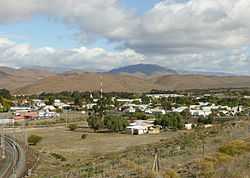Laingsburg, Western Cape
| Laingsburg | |
|---|---|
|
A view of Laingsburg | |
 Laingsburg
| |
| Coordinates: 33°11′42″S 20°51′33″E / 33.19500°S 20.85917°ECoordinates: 33°11′42″S 20°51′33″E / 33.19500°S 20.85917°E | |
| Country | South Africa |
| Province | Western Cape |
| District | Central Karoo |
| Municipality | Laingsburg |
| Established | 1879 |
| Area[1] | |
| • Total | 723.72 km2 (279.43 sq mi) |
| Population (2011)[1] | |
| • Total | 5,667 |
| • Density | 7.8/km2 (20/sq mi) |
| Racial makeup (2011)[1] | |
| • Black African | 8.2% |
| • Coloured | 82.3% |
| • Indian/Asian | 0.3% |
| • White | 8.5% |
| • Other | 0.7% |
| First languages (2011)[1] | |
| • Afrikaans | 93.6% |
| • English | 1.7% |
| • Xhosa | 1.6% |
| • Other | 3.1% |
| Postal code (street) | 6900 |
| PO box | 6900 |
| Area code | 023 |
Laingsburg is a town located in the Western Cape province in South Africa.
History
The original inhabitants of the region were the Khoikhoi herders and the San hunter gatherers. Following the arrival of the early European colonists, the area was settled by Afrikaner Trekboers and Griqua people.
Railway origins
In the 1870s, the government of Prime Minister John Molteno oversaw a massive expansion of the Cape Colony's railway system.[2] The route (chosen by the Prime Minister with a map, pen and ruler) ran past a farm named Vischkuil-aan-de-Buffelsrivier (fishing pond on the Buffalo River) which a man called Stephanus Greeff then bought for the purpose of development.[3]
Name changes
The line was completed in 1878 and a small siding named Buffelsrivier was built at the farm. With railway access, a town soon began developing. It was soon renamed Nassau to avoid confusion with Buffalo River in East London, and finally changed to the name Laingsburg, after John Laing who was Commissioner of Crown Lands at the time.
Municipality
The town was laid out in 1881 and became a municipality in 1904. The Laingsburg Local Municipality has since been expanded to include Bergsig, Goldnerville and Matjiesfontein.
1981 Flash flood
On 25 January 1981, in Laingsburg's centennial year, the largest part of the town was swept away within minutes by one of the strongest floods ever experienced in the Great Karoo. After a cloud burst to the north-eastern hinterland, south of the Komsberg, a massive wall of water rushed down the Buffels River and swept away everything it encountered in its way. Animals, humans and their possessions were swept along and later dumped under meters of silt. Hydrologists estimate that a flood in Laingsburg of this magnitude has a recurrence interval of once, on average, every 100 years.
Before the flood, rain initially started with a light drizzle that was welcomed by farmers in the area, since it didn't rain often. But, the soil of the area is of such a nature that it can't absorb much rainwater. The consequence is that water drains directly into the rivers. Water built up in both the Baviaans and Buffels Rivers and their confluence at the little town. The rivers quickly grew from normally small streams to a roaring wall of water almost 6 m high. Within hours the whole town was under water and residents had to fight for their lives.
Geography
Laingsburg is situated along the N1 route, at Lat: -33.20, Long: 20.85, in the Western Cape province of South Africa.
The town is situated in the Great Karoo, a semi-desert region of South-Africa. The town's total rainfall is about 150mm per year. The main water supply is the Buffels River. Summers are extremely hot and dry, with temperatures usually exceeding 30°C. Winters are crisp to sometimes very cold, with snow occasionally occurring in the surrounding region.
Economy
Laingsburg's economy is mainly based on farming of goats, sheep, lucerne (Alfalfa), fruit and vegetables.
References
- ↑ 1.0 1.1 1.2 1.3 "Main Place Laingsburg". Census 2011.
- ↑ Burman, Jose (1984). Early Railways at the Cape. Cape Town. Human & Rousseau, p.58. ISBN 0-7981-1760-5
- ↑ Royal Colonial Society: Proceedings of the Royal Colonial Institute. Northumberland Avenue, London. 1898. p.26. "The Railway System of South Africa".
External links
| |||||||||||||||||||||

.svg.png)